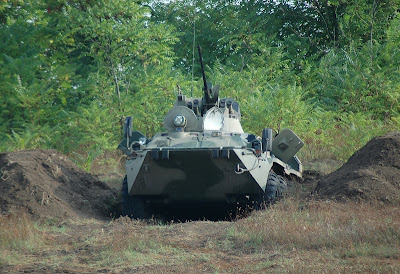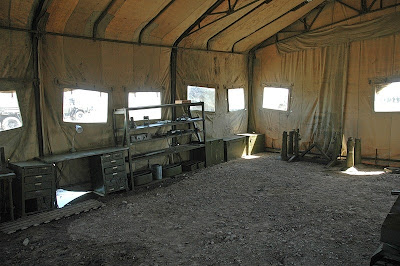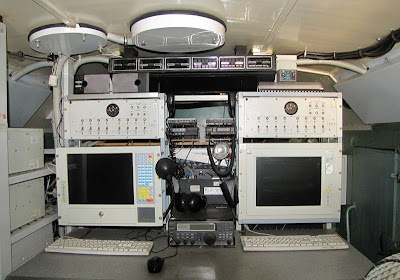Let's have a look at the military equipment of the 18th motorized rifle brigade dislocated in Georgia.
The brigade has been rearmed with new equipment. After Georgia had been enforced to peace, old tanks T-62 were substituted for T-72B and T-72B(M).
Tank T-72B is one of the most widely produced post-World War II tanks, second only to the T-54/55 family, and the basic design has also been further developed as the T-90.
Tanks T-72B(M) supplied with Contact-5.
Tank T-72B(M).
Armored transport vehicles BTR-80 are slowly substituted by new and modern BTR-82A. Complete substitution of BTR-80 took place this year.
The BTR-82 wheeled armored vehicle features energy absorbing structures, a more powerful diesel engine developing 300-hp of power, crew and passengers special suspension seats, a sophisticated fire suppression system, reinforced floor protection against mines and improvised explosive devices (IEDs), higher rate of firepower, improved ballistic protection, command, increased survivability by 20 percent, reliability and mobility.
Changes to the better were also observed for communication technology. BTR-80 is located on the left and R-149 BMR – on the right.
Command and control vehicle P-166-0,5.
Old control and command vehicles such as P-142H are used as well.
New air defense missile systems TOR.
New models of "Urals" and 'KamAZes' were purchased as well.
Armored 'KamAZes'.
Armored "Urals".
Р-149 BMR, BTR80, BTR-82А and armored KAMAZ.
Break-down vehicles.
KT-LM, light evacuation transporter.
Filed kitchen of KAMAZes.
Cystern CV-12 and kitchen KP-130.
AC 6,0-40.
New maintenance vehicles.
Inside the machine.
2S3 Akatsiya 152-mm self-propelled artillery system. The 2S3 Akatsiya uses a modified tracked chassis of the Krug (SA-4 Ganef) surface-to-air missile system. Vehicle is powered by a V-59 diesel engine, developing 520 hp. Two self-propelled howitzers of this type can be airlifted by the An-22 military cargo aircraft.
The BM-21 launch vehicle, a Soviet truck-mounted 122 mm multiple rocket launcher, and a M-21OF rocket were developed in the early 1960s. The complete system is more commonly known as a Grad multiple rocket launcher system. In NATO countries, the system was initially known as M1964. Several other countries have copied it or developed similar systems.
The field sauna is designed to take in 60 people an hour.
Inside the sauna.
Control post of electronic combat. It is designed for collection and processing of data, conduction of radio-surveillance and control of other posts. It can handle monitoring of 10 stations simultaneously.
Automatized jamming station.
The station finds, locates, and radio suppresses mobile stations of satellite communications systems. As soon as the station starts functioning, it is not possible for the enemies to detect it. Having produced influence of the enemy, the station changes its location at once. However, the opposite forces can bombard the entire area where the station can be located.
Station of radio surveillance P-934. It has been exploited since 2007 and can search, detect, analyze signals, and work in three regimen such as centralized, leading/led together with another station and autonomous.
Station of radio surveillance is used mainly for signal suppression. In case the information is not needed, it is suppressed, and can be passed on to the radio-electronic surveillance as soon as it becomes valuable.
The stations of radio surveillance are used to detect the source of a signal and its location.
Modernized BRDM-2М is an amphibious armoured patrol car. It was also known under designations BTR-40PB, BTR-40P-2 and GAZ 41-08. This vehicle, like many other Soviet designs, has been exported extensively and is in use in at least 38 countries. It was intended to replace the earlier BRDM-1 with a vehicle that had improved amphibious capabilities and better armament.
The 3C-82 loudspeaker.
Control station.
The brigade has been rearmed with new equipment. After Georgia had been enforced to peace, old tanks T-62 were substituted for T-72B and T-72B(M).
Tank T-72B is one of the most widely produced post-World War II tanks, second only to the T-54/55 family, and the basic design has also been further developed as the T-90.
Tanks T-72B(M) supplied with Contact-5.
Tank T-72B(M).
Armored transport vehicles BTR-80 are slowly substituted by new and modern BTR-82A. Complete substitution of BTR-80 took place this year.
The BTR-82 wheeled armored vehicle features energy absorbing structures, a more powerful diesel engine developing 300-hp of power, crew and passengers special suspension seats, a sophisticated fire suppression system, reinforced floor protection against mines and improvised explosive devices (IEDs), higher rate of firepower, improved ballistic protection, command, increased survivability by 20 percent, reliability and mobility.
Changes to the better were also observed for communication technology. BTR-80 is located on the left and R-149 BMR – on the right.
Command and control vehicle P-166-0,5.
Old control and command vehicles such as P-142H are used as well.
New air defense missile systems TOR.
New models of "Urals" and 'KamAZes' were purchased as well.
Armored 'KamAZes'.
Armored "Urals".
Р-149 BMR, BTR80, BTR-82А and armored KAMAZ.
Break-down vehicles.
KT-LM, light evacuation transporter.
Filed kitchen of KAMAZes.
Cystern CV-12 and kitchen KP-130.
AC 6,0-40.
New maintenance vehicles.
Inside the machine.
2S3 Akatsiya 152-mm self-propelled artillery system. The 2S3 Akatsiya uses a modified tracked chassis of the Krug (SA-4 Ganef) surface-to-air missile system. Vehicle is powered by a V-59 diesel engine, developing 520 hp. Two self-propelled howitzers of this type can be airlifted by the An-22 military cargo aircraft.
The BM-21 launch vehicle, a Soviet truck-mounted 122 mm multiple rocket launcher, and a M-21OF rocket were developed in the early 1960s. The complete system is more commonly known as a Grad multiple rocket launcher system. In NATO countries, the system was initially known as M1964. Several other countries have copied it or developed similar systems.
The field sauna is designed to take in 60 people an hour.
Inside the sauna.
Control post of electronic combat. It is designed for collection and processing of data, conduction of radio-surveillance and control of other posts. It can handle monitoring of 10 stations simultaneously.
Automatized jamming station.
The station finds, locates, and radio suppresses mobile stations of satellite communications systems. As soon as the station starts functioning, it is not possible for the enemies to detect it. Having produced influence of the enemy, the station changes its location at once. However, the opposite forces can bombard the entire area where the station can be located.
Station of radio surveillance P-934. It has been exploited since 2007 and can search, detect, analyze signals, and work in three regimen such as centralized, leading/led together with another station and autonomous.
Station of radio surveillance is used mainly for signal suppression. In case the information is not needed, it is suppressed, and can be passed on to the radio-electronic surveillance as soon as it becomes valuable.
The stations of radio surveillance are used to detect the source of a signal and its location.
Modernized BRDM-2М is an amphibious armoured patrol car. It was also known under designations BTR-40PB, BTR-40P-2 and GAZ 41-08. This vehicle, like many other Soviet designs, has been exported extensively and is in use in at least 38 countries. It was intended to replace the earlier BRDM-1 with a vehicle that had improved amphibious capabilities and better armament.
The 3C-82 loudspeaker.
Control station.








































































